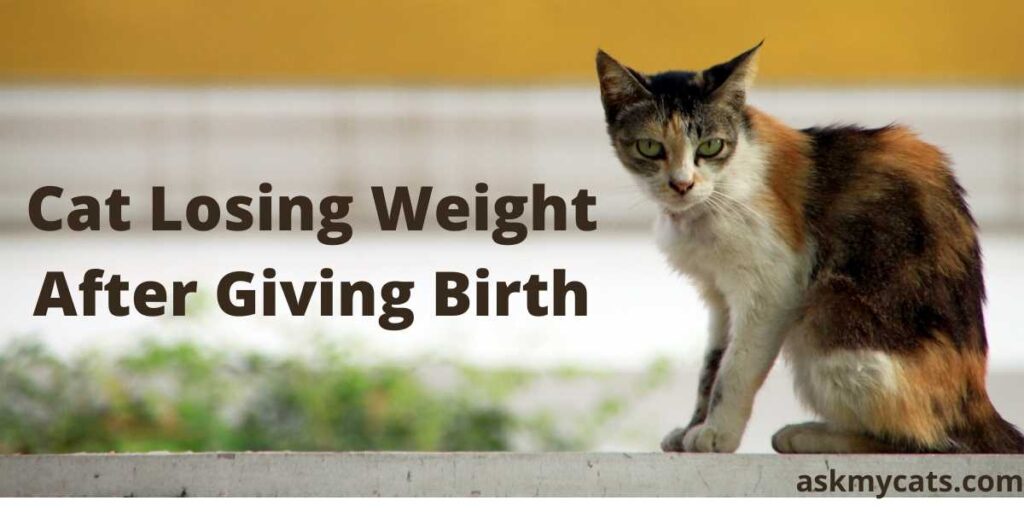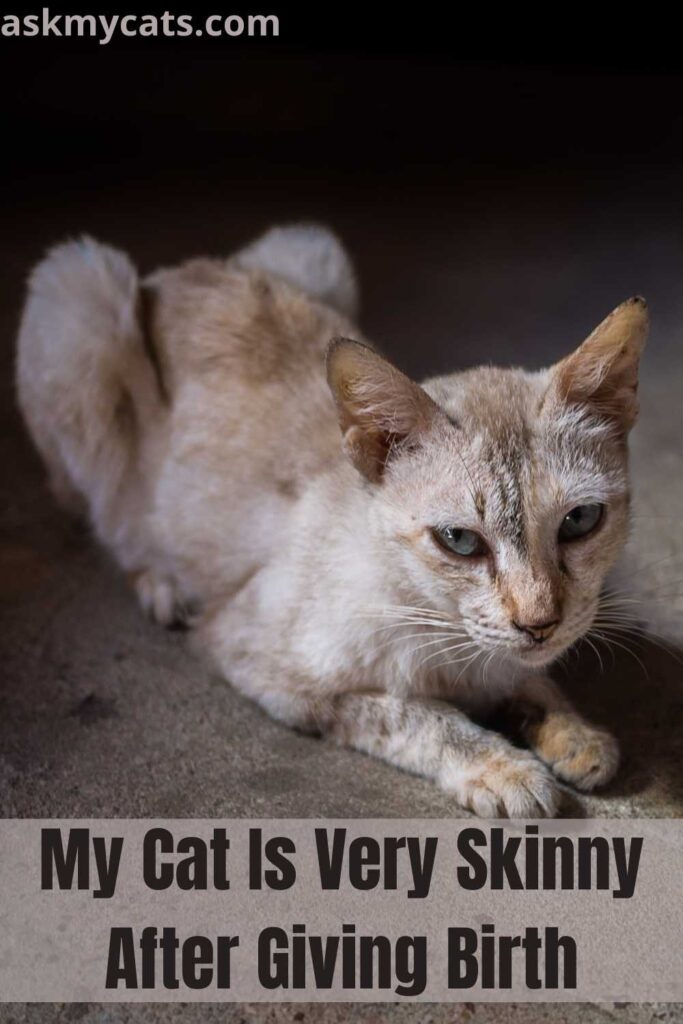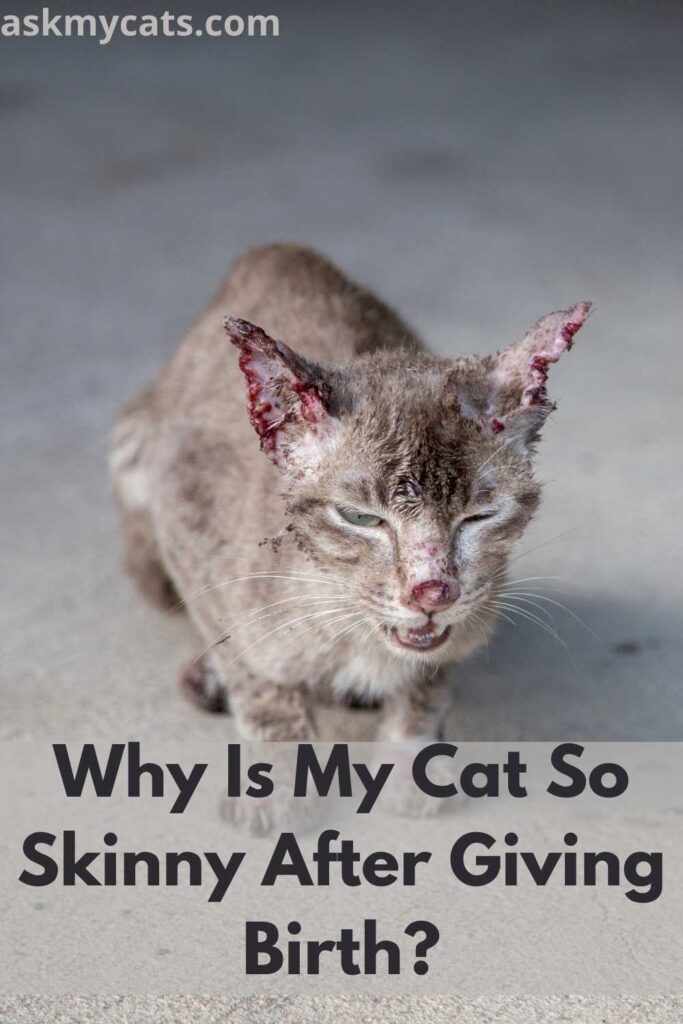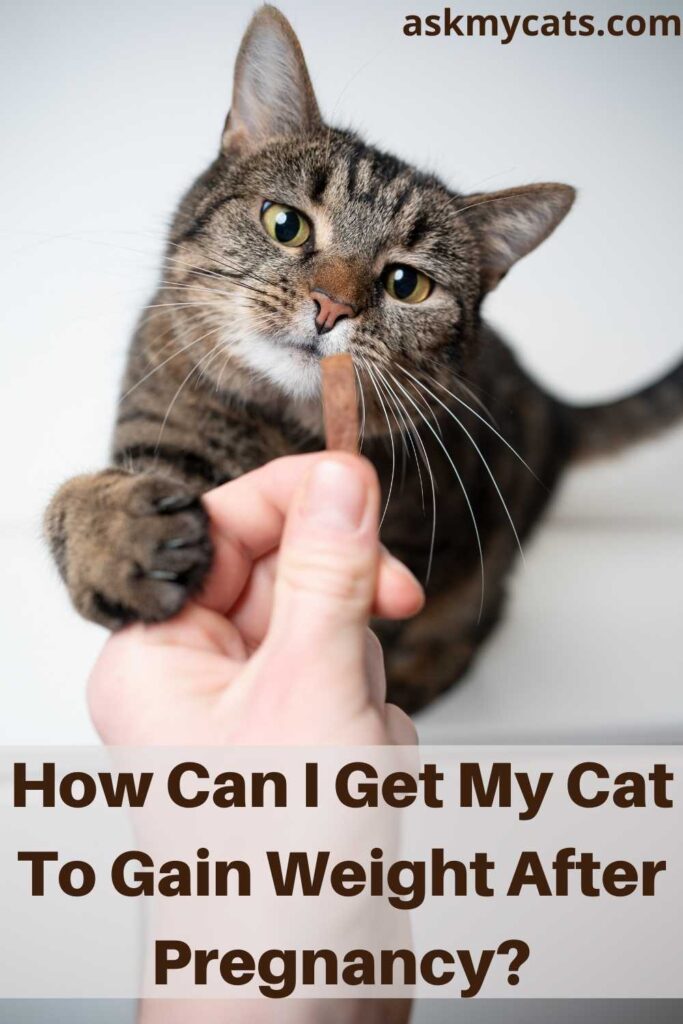Pregnancy and nursing cause many changes in a cat’s lifestyle as well as her body. Throughout the reproduction process, you should pay close attention to your cat’s changing nutritional needs.
So, why is your cat losing weight after giving birth?
A cat might be losing weight after giving birth because of complications or an increase in nutritional needs.
Keep reading the article, to know more about why your cat is losing weight after giving birth.


Give Your Cat the Perfect Day
Get the Free Ebook!
My Cat Is Very Skinny After Giving Birth
Keeping medical complications aside, a cat could become skinny after giving birth due to increased nutritional needs.

After giving birth, pregnant cats lose weight. Their nutritional requirements, however, skyrocket.
Depending on litter size, energy requirements can be two to three times normal in order to produce enough milk to support the offspring.
Water consumption is also essential for milk volume.
Anxiety, stress, or depression may occur. Cats who are under psychological stress may stop eating, resulting in weight loss.
Excessive noise, other animals in the feeding area, dirty food dishes, or proximity of the food dish to the litter box can all irritate your cat.
Cats can also be distressed by the loss of another pet or a change in routine.
Give a nursing cat a nutrient-dense diet, such as kitten food, to ensure she gets enough nutrition.
Increase the number of meals per day without increasing the amount of food at each meal. Feed her at her leisure, with unlimited access to dry food.
Most kittens show an interest in their mother’s food by 5 weeks. The kittens will gradually start eating solid food and nursing less.
At the same time, the nursing cat will typically begin to eat less. Most kittens are fully weaned by eight weeks of age.
By this point, the mother’s energy requirements should have returned to normal, and she should be eating her pre-pregnancy diet.
You might also like to read about Why Is My Cat Not Eating After Giving Birth?
Why Is My Cat So Skinny After Giving Birth?
Here are some reasons why your cat might be so skinny after giving birth: –

1. Retention of Fetal Membranes
After birthing, a queen may fail to pass the final set of fetal membranes/tissue.
When this happens, the membranes in her uterus begin to degrade and rot.
The queen frequently becomes restless and uncomfortable in her belly area, and she will refuse to nurse, lay with, or care for her kittens.
She may eat little or refuse food and water, and she may have a brownish vaginal discharge.
If you notice any of these symptoms, your cat needs to see a veterinarian right away.
The veterinarian may suggest diagnostic tests as well as appropriate treatment, which could include antibiotics, pain relievers, and hospitalization.
2. Metritis or Endometritis
Metritis and endometritis are both types of uterine inflammation. In cats, it usually occurs within three days of birth.
Queens will be much sicker than if fetal membranes are retained. Fever, complete disregard for her kittens, refusal of food, and lack of activity are all symptoms.
In addition, she may vomit and drink more water than usual. A foul-smelling, deep red wine or black-colored discharge will be visible from her vagina.
She requires emergency veterinary care, which will include a thorough examination, diagnostic tests, and supportive care such as intravenous (IV) fluids, antibiotics, pain management, and other services.
3. Mastitis
Mastitis, or mammary gland inflammation, can occur during early lactation or nursing. Mastitis usually affects one mammary gland and causes it to become firm, hot, painful, and enlarged.
If the cause is simply congestion of the milk ducts, gentle heat and massage will allow milk to flow out of the teat orifice or opening.
Milking the affected gland gently can quickly alleviate the situation. If the mastitis is caused by an infection, the gland will be painful, swollen, and have an abnormally colored discharge from the nipple, and the cat will refuse food, become feverish, and become inactive.
A purplish area of tissue with thick, foul-smelling discharge can also result from an abscess.
Mastitis caused by infection necessitates immediate veterinary care, which will include a thorough examination, diagnostic tests, and supportive care such as intravenous (IV) fluids, antibiotics, pain management, and more.
4. Eclampsia (Milk Fever)
Eclampsia, also known as milk fever or lactation tetany, can occur 3-5 weeks after kitten birth.
This is caused by a sudden decrease in the amount of calcium circulating in the nursing queen’s bloodstream, which is caused by increased milk production demands. The cat is frequently nursing a large litter of kittens.
Restlessness, panting, muscle tremors, and incoordination are early symptoms of milk fever. It can progress to tetanic (rigid, stiff-legged) muscular spasms, convulsions (seizures), or coma if not treated.
This is a potentially fatal condition. Seek veterinary care right away if you suspect your cat is suffering from milk fever.
The condition is quickly reversed with IV injections of calcium preparations. The queen may need to be hospitalized and her calcium levels monitored until she is stable.
Remove the kittens from the queen and provide them with bottle feeding or weaning if they are old enough.
Milk fever recurs frequently in affected queens with subsequent litters. Due to the increased risk of recurrence, consult your veterinarian before continuing to breed an affected queen.
5. Cesarean Section (C-section)
After a C-section, keep a close eye on the queen for the first 2-3 days. Ascertain that she is comfortable, eating, drinking, nursing, and caring for the kittens and that she is urinating and passing a normal stool.
Keep an eye on her incision for signs of pain, heat, swelling, or discharge. If you notice any of these symptoms, please contact your veterinarian.
Ensure that she receives all medication prescribed by the veterinarian, including antibiotics and pain relievers.
Interesting Read: Why Is My Pregnant Cat Not Eating?
How Much Weight Does A Cat Lose After Birth?
A cat can lose about 40% weight after giving birth.
Queens will lose approximately 40% of the weight they gained during pregnancy at delivery. The remainder of the weight will be lost during lactation as a result of the strain placed on the queen’s body.
The queen can increase her food intake after the kittens are born because she has more room in her abdomen, but the energy density of the food must be high or she will not be physically able to consume enough to sustain milk production, weight, and body condition.
Periodic assessments of the queen’s body condition allow for fine-tuning of feedings. Lactation feeding, like pregnancy feeding, is best accomplished with a highly digestible, high-quality kitten formulation.
Peak milk production and the queen’s peak energy requirements occur three to four weeks into lactation, but peak food requirements occur six to seven weeks after birth.
Remember that as they approach weaning age, the kittens are also consuming the queen’s food.
Unless the cat only has one or two kittens, free-choice feeding during the first three to four weeks of lactation provides numerous benefits.
The queen can eat on her own timetable, consuming smaller amounts of food each time she eats, and the kittens can start tasting solid food as soon as they are able (at about three weeks of age).
Interesting Read: Why Is My Cat Still Fat After Giving Birth?
How Can I Get My Cat To Gain Weight After Pregnancy?
You can get your cat to gain weight after pregnancy by giving her a high calory diet.

To ensure that a nursing cat gets enough nutrients, feed her a nutrient-dense meal.
Increase the number of meals per day without increasing the amount of food consumed at each meal.
Feed her whenever she wants, with full access to dry food.
Ascertain that the cat is getting enough protein. A nursing cat will need a lot of protein to stay healthy and deliver nourishment to her kittens.
High-quality cat food contains a lot of protein. However, if her kittens are highly active or loud, it could be a sign that the mother isn’t getting enough protein.
If in doubt, feed the kitten to the mother cat while she is nursing. Human food is higher in calories, calcium, and protein than kitten food.
Mother cats should take a high-quality kitten formula meal while breastfeeding. If she’s a finicky eater, don’t be hesitant to feed her canned tuna, chicken, or salmon.
In order for a mom to continue feeding her babies, she needs to maintain a high-calorie intake. Ascertain that she has constant access to fresh water.
Also, check out How To Fatten Up A Nursing Cat?
You must feed your female cat food that will sustain her and her kittens both before and after they are born if she is pregnant or has recently given birth and is nursing her kittens.
Your cat will require high-calorie food to both nourish the kittens and keep herself healthy while they are developing and growing.
You’ll need to provide her with high-calorie food while she’s feeding her litter because lactation is a physically demanding process for a cat.
Replace your cat’s dry cat food with wet kitten food. Around the halfway point of her pregnancy, switch your cat to high-quality wet kitten food.
Kitten food contains more minerals and vitamins than adult cat food, so it will provide more protein and calories to the queen during her pregnancy.
Keep in mind that your cat’s food consumption will increase during pregnancy. She’ll eat around half as much as she would if she weren’t pregnant.
A cat’s pregnancy lasts between 58 and 70 days on average. You should be able to shift your queen to the healthy kitten diet by the fifth week (35 days).
Ensure that your cat has constant access to food. As the pregnancy progresses and the litter of kittens takes up more space inside of her, your queen will eat fewer and smaller meals, but her meals will grow more frequently.
As a result, make sure your hungry cat has access to food at all times. Instead of feeding her at specific meal times, you can leave food out.
Wet food that has been left out too long may deteriorate. To avoid this problem, start with a small amount of wet food and wait until your cat finishes it before adding more.
Your cat’s usual diet can be supplemented with protein. During the early and middle stages of pregnancy, your cat can eat regular food.
However, you should provide more protein to aid your kitten’s growth. To achieve this, boil small bits of chicken, beef, fish, or egg and add them to your cat’s dry or wet diet.
Cats, especially those that are pregnant, can be picky eaters. Experiment with different proteins until you find one that your cat likes.
The additional protein in the mother cat’s body will supply her with strength and energy as the kittens grow. During her pregnancy and nursing, the mother will need a lot of protein.
You must check out What To Feed Mother Cat After Giving Birth?
Frequently Asked Questions
When should I start weaning my kittens?
Weaning is often carried out in phases. Most kittens begin eating solid food between the ages of three and four weeks. Between the ages of 6 and 10 weeks, weaning should be completed. To begin the weaning process, remove the mother and kitten for a few hours at a time. As a result, the kittens’ dependency on their mother and her milk will gradually reduce. Both the mother and the kitten should have their own area with food, drink, and a litter box.
Why is it so necessary for lactating cats to have more energy and fat?
Cats who are pregnant or breastfeeding require a lot of energy, thus extra energy and fat are essential. Nursing is the most energy-intensive part of a cat’s existence. Nursing cats require 2 to 6 times the energy of an adult cat. Digestibility refers to the amount of food consumed that is actually absorbed by the cat’s body. Excellent digestibility is crucial since energy requirements are high and there is less physical space in the tummy of pregnant cats.
When are kittens supposed to stop drinking milk?
Kittens drink their mother’s milk until the mother weans them, which can happen as early as four weeks of age. Kittens begin eating solid foods at the age of eight to ten weeks. Although kittens can drink their mother’s milk, many cats lose their ability to digest it after weaning. “Cats generally lose their ability to digest the sugar found in milk after weaning because solid food takes its place and they no longer need this ability,” scientists explain. This varies, and some cats can continue to metabolize milk sugar far into maturity, if not their entire lives.”
Final Words
There are a variety of reasons why your cat looks to be underweight, after giving birth. After speaking with your vet and clearing out all medical complications, feed her a high-calorie, high-protein meal to help her gain weight.
Ask us questions in the comments section if you have any.
Also, check out Why Is My Nursing Cat Always Hungry?
